Elevate Your Style: Suit, Vest, and Bowtie Essentials
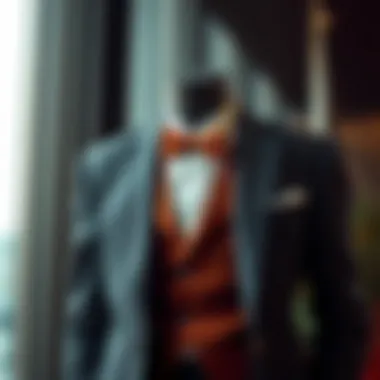
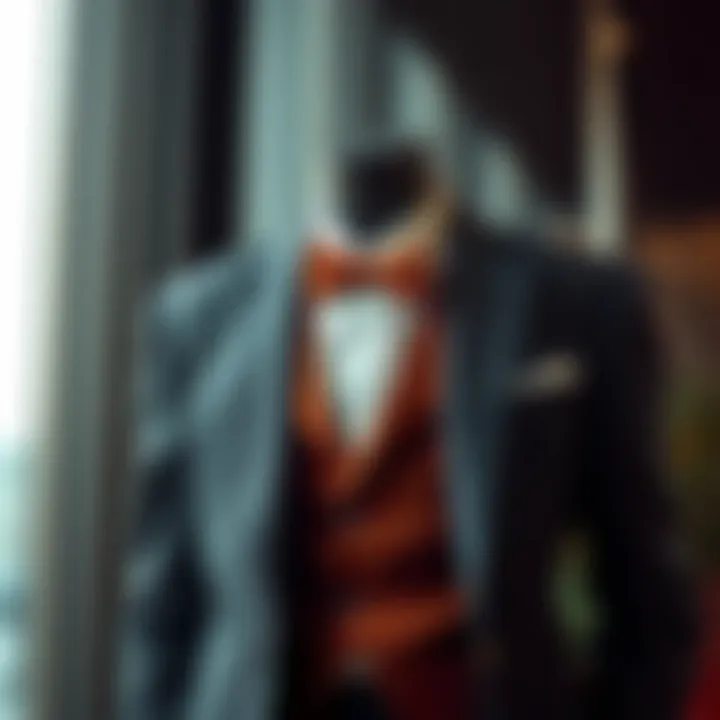
Intro
In the realm of menswear, the combination of a suit, vest, and bowtie holds a unique and storied place. It is a triumvirate that straddles the line between formal elegance and personal expression. Every time a man dons this ensemble, he is not just putting on clothes; he is engaging in a conversation with history, style, and the unwritten rules of fashion that have evolved over generations. This article delves into this intricate tapestry, exploring the myriad ways this classic outfit has transitioned from traditional formalities to modern style statements.
This multifaceted examination will cover various aspects of the suit, vest, and bowtie combination. From the historical significance that these pieces carry, to how they are interpreted today in contemporary contexts, every detail plays a pivotal role. Additionally, we’ll discuss how to approach fabric choices and color palettes that suit various occasions—keeping in mind the ever-important factor of sustainability in fashion.
With a careful look at the current trends influencing this ensemble and insightful styling tips, we aim to provide you with a comprehensive guide that not only informs but inspires. Whether you are a fashion designer looking for fresh ideas or a stylist seeking to refine your client's wardrobe, or perhaps a lover of fashion wanting to add some suave elements to your attire, this narrative is tailored for you.
Historical Context of the Suit, Vest, and Bowtie
The narrative surrounding the suit, vest, and bowtie weaves a rich tapestry of cultural history and fashion evolution. Understanding their historical significance isn't merely an exercise in nostalgia; it's essential for grasping their relevance in today's sartorial landscape. Each element speaks volumes about societal norms, personal expression, and even the economics of fashion.
Origins of the Suit
The suit, as we recognize it today, has its roots in the 17th century, where the concept of tailored clothing began to take shape in Europe. Initially, garments were simple and often included long coats. These evolved as the tailoring craft matured, especially during the reign of King Charles II of England, who popularized shorter coats and matching trousers. Known as the "justaucorps," this early form of a suit emphasized the silhouette of the wearer—a functional yet stylish choice that laid the groundwork for formal attire. In the same vein, the fabrics used grew increasingly luxurious, reflecting growing wealth and status.
In the decades that followed, especially during the Victorian era, suits became more structured, featuring a distinct three-piece design. As industrialization kicked into gear, mass production of suits made tailored clothing accessible to a broader market. This accessibility didn’t compromise quality, however; rather, it set the stage for the modern interpretation of the suit as an essential item in every man’s wardrobe.
Evolution of the Vest
The vest’s journey is equally intriguing. Originally known as a "waistcoat," it emerged in the 17th century and became a key component of men’s fashion. This versatile piece once served a practical purpose, offering warmth beneath a coat. As fashions transformed through history, particularly in the 18th century, the waistcoat evolved into a statement piece—often elaborately designed with intricate patterns and colors.
Eventuallly, the vest became a canvas for creativity, reflecting the personality of its wearer. In the 19th century, alterations in societal norms led to a more subdued aesthetic. The vest became a subtle contrast to the more eye-catching components of a suit, now often found in solid colors or simple designs. Despite its modesty, the vest retained its importance, enriching formal wear by adding depth and sophistication to the overall ensemble.
The Bowtie's Journey Through Time
The bowtie’s history is not just about decoration; it’s a chronicle of changing moods and styles. The bowtie's origins can be traced back to Croatian mercenaries in the 17th century, who wore cloth bands around their necks to hold up their shirts. This functional garment quickly transitioned into a fashion statement during the 19th century, and by the time the 20th century dawned, it had solidified itself as a classic choice for gentlemen.
Significantly, the bowtie serves variably in different contexts. For example, it can indicate formality at tuxedo events or provide a dash of whimsy in smarter-casual settings. It's this versatility that underscores its importance in modern men's fashion. The bowtie is not just an accessory; it symbolizes individuality and a certain rebellious spirit within the confines of traditional male dressing. When combined with a suit and vest, it creates an aura of sophistication with a twist.
"History is a present that is unfolding, much like a well-tailored suit that shapes our identities each day."
The historical context of the suit, vest, and bowtie is not simply a backstory; it serves as a roadmap for today's wearers. Understanding these elements helps individuals appreciate their outfits more deeply, elevating mere clothing into expressions of personal style and sophistication.
Analyzing the Components of the Ensemble
Examining the essential parts of a suit, vest, and bowtie combo provides vital understanding into how each contributes to achieving a refined look. Each component is far more than just fabric stitched together; they represent various styles, cultural nuances, and functions that have evolved over time. To fully appreciate the elegance of the ensemble, attention must be paid to how these elements work in harmony to create an aesthetic that resonates with sophistication and intent.
Structure of a Tailored Suit
A well-structured suit serves as the foundation of this ensemble. The suit is not merely a piece of clothing; it has numerous facets that affect comfort and appearance. Key features include the cut, fit, and style, notably the lapels and pockets.
- Cut: The cut refers to the silhouette of the suit, whether it's slim, regular, or tailored. A slim fit is modern, while a classic cut speaks to traditional elegance.
- Fit: Tailoring is critical. Custom fittings ensure that the suit contours to the wearer’s body, making movement easy without compromising aesthetics.
- Lapel styles: Notches, shawls, or peak lapels carry their own significance in fashion. Each style speaks volumes about formality and occasion.
To grasp the significance of the suit, consider this:
"The suit is an invitation to express personal style while adhering to social norms."
Impeccable tailoring communicates professionalism and respect for the occasion, making it an essential part of the ensemble.
The Function and Styling of the Vest
The vest, often an underappreciated player in formal attire, adds layers of sophistication and dimension. Often opening the door to various styling options, it can be worn with or without a jacket. There are several functionalities and styling elements to consider:
- Layering Effect: When you layer a vest beneath a suit jacket, you introduce texture and depth. This adds visual interest, making the attire appear more polished.
- Formality Enhancement: A vest elevates the level of formality in a suit ensemble. It can make a traditional suit appear more contemporary and stylish.
- Practical Use: Vests can also come with pockets that add functional benefits without compromising aesthetics.
In terms of styling, choosing a vest that complements the suit color and fabric can be a game-changer. Patterns and textures can create contrast or harmony, depending on what the wearer intends to convey.
Types and Styles of Bowties
Bowties, like stars in the sky, come in many styles and types, each offering a unique personality to the ensemble. Delving into their world reveals a variety of fabric choices, shapes, and tying methods:
- Shapes: The butterfly, batwing, and diamond point shapes each appeal to different sartorial tastes. The butterfly is classic, while the batwing is slightly more subdued.
- Fabrics: Traditional silk remains a favorite, but modern options include cotton, wool, and linen. Each fabric offers distinct texture and comfort levels, influencing the overall look and feel of the outfit.
- Tying Methods: Pre-tied bowties offer convenience, while self-tied options showcase a sense of craftsmanship and authenticity. The level of difficulty involved in tying a bowtie can also reflect the wearer's commitment to personal style.
To summarize, bowties complete the ensemble, allowing an individual to express not just style but also creativity and elegance within the framework of formal dress.
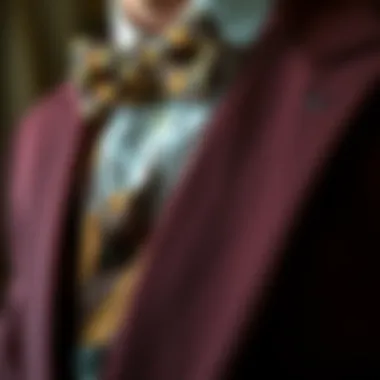

Overall, understanding these components enhances one’s ability to curate an outfit that not only looks good but feels personal and meaningful. As sartorially inclined individuals navigate their way through the world of men's fashion, these elements become tools for crafting narratives in how they are perceived by others.
Choosing Fabrics for Each Element
Choosing the right fabric for each component in a suit and vest ensemble is crucial. It’s not just about aesthetics, but also about functionality, comfort, and occasion. The fabric you select can drastically alter not just the overall appearance but also how it feels against the skin. Breathability, weight, texture, and stretch play significant roles in how well an outfit will serve its purpose. Therefore, understanding fabric options is essential for making informed choices that enhance both style and comfort.
Suit Fabrics: Wool vs. Synthetic
When it comes to suits, wool has long been heralded as a classic choice. Its natural fibers offer a beautiful drape and inherent breathability, which helps regulate body temperature. Wool suits are often sturdy and resilient, ideal for both formal and business settings. However, not all wool is created equal; fine wool fabrics like Tweed or Super 100s provide great color depth and structure.
In contrast, synthetic fibers, such as polyester or rayon, are becoming increasingly popular thanks to their affordability and ease of care. They are less prone to wrinkling, which can provide a polished look throughout the day. However, they might lack the luxurious feel and breathability that some individuals crave. For example, a polyester wool blend could be a good compromise, offering some benefits of both materials.
- Wool:
- Synthetic:
- Pros: Breathable, durable, luxurious feel.
- Cons: More expensive, can be heavier.
- Pros: Affordable, low-maintenance, wrinkle-resistant.
- Cons: Less breathable, can feel cheap.
Selecting the Right Vest Material
Choosing the right vest material can elevate the entire ensemble to new heights. Different occasions may demand different textures and appearances. For formal events, a plain wool vest can create a sleek silhouette that complements the suit beautifully, adding an element of sophistication.
On more relaxed occasions, consider vests made from cotton or linens. These materials offer a more approachable feel while still maintaining structure. Cotton vests can easily command attention when paired with the right patterns or colors. Remember that a vest can also change the perception of the suit; a sharply tailored vest in silk can add just the right touch of elegance for an evening event.
- Wool:
- Cotton & Linen:
- Perfect for formal occasions, pairs well with most suit fabrics.
- Adds weight and structure.
- More suited for casual settings.
- Lightweight and breathable.
Bowtie Fabrics: Silk and Beyond
Bowtie fabrics may seem straightforward, but they play a vital role in achieving a cohesive look. Silk is the gold standard for bowties due to its luxurious sheen and soft texture. It drapes beautifully and can come in myriad patterns, adding flair to any outfit.
However, exploring beyond silk unveils a treasure trove of options. Cotton bowties offer a more laid-back demeanor and can often incorporate playful designs. Velvet is another attractive option, perfect for winter or evening wear, adding richness that can elevate your attire to the next level. Moreover, materials like tweed or knitted fabric provide an intriguing twist for those looking to stand out.
- Silk:
- Cotton & Velvet:
- Pros: Elegant, various patterns, great for formal events.
- Cons: Requires careful maintenance.
- Perfect for casual or semi-formal events, softer feel.
- Velvet can be heavy but adds a luxurious touch.
"The fabric you choose speaks volumes about your style. Make sure it's not just what feels good, but what tells your story."
Remember, paying attention to the kind of fabrics you choose for suits, vests, and bowties can hugely impact your overall presence in any social or professional setting.
Color Theory in Fashion Choices
Color theory plays an instrumental role in the realm of fashion, particularly when it comes to men's attire like suits, vests, and bowties. It’s not just about picking a favorite shade; it involves understanding how colors interact, evoke emotions, and set the tone for various occasions. For designers and stylists, this knowledge becomes invaluable, allowing for nuanced combinations that amplify the sophistication of the ensemble.
When assembling a polished look, considering each color’s psychological impact is essential. Different colors can convey different messages—darker tones tend to project authority and confidence, while lighter shades evoke feelings of openness and warmth. This awareness helps in making informed choices that align with the desired image.
Understanding Color Combinations
Creating a successful outfit involves balancing colors in a way that is visually appealing. The basic principles of color combinations can be broken down into complementary, analogous, and triadic schemes.
- Complementary Colors: These are colors directly opposite each other on the color wheel, such as blue and orange. Using complementary shades can create a striking, energetic contrast, necessary for a standout look.
- Analogous Colors: These colors sit next to each other on the color wheel, like blue, blue-green, and green. This combination provides harmony and is less jarring to the eye, ideal for more understated settings.
- Triadic Colors: This involves using three colors that are evenly spaced around the wheel, like red, blue, and yellow. This can create a balanced yet vibrant aesthetic, particularly for more casual or creative occasions.
Using tools like the color wheel can simplify this process for anyone—and there's a lot of intuitive interplay among hues that can guide selections.
Choosing a Palette for Different Occasions
The occasion often dictates which shades will resonate best.
- For formal events, darker colors—like charcoal, navy, or even deep burgundy—typically embody tradition, while subtly introducing textures or minor details in bowtie or vest design can offer unique flair.
- Casual gatherings can lean toward lighter hues, soft patterns, or even pastels to keep the vibe relaxed yet stylish. Think pale blues, light greys, and gentle earth tones. Mixing in textures with fabrics not only enriches the aesthetic but also contributes to comfort.
- Seasonal factors should also not be neglected. In spring or summer, lighter shades tend to breathe freshness into appearances, whereas autumn and winter favor deeper tones like forest green or burnt orange to reflect the season’s spirit.

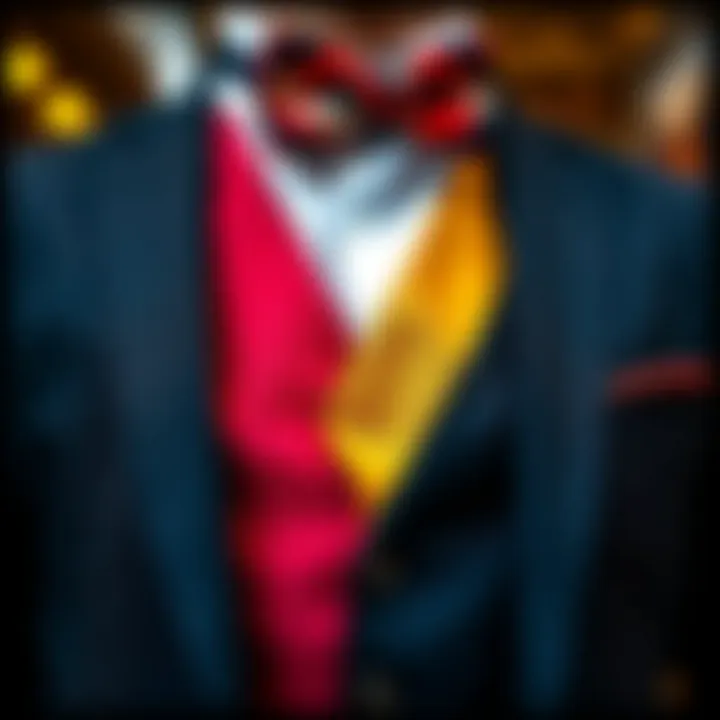
The Impact of Color on Perception
The interplay of color has profound effects on how one is perceived in social situations. Research indicates that colors can sway judgments people make about character and even competence. For instance, wearing black often conveys a sense of power, while colors like pink might project a softer, gentler side.
Furthermore, color's influence can extend beyond immediate appearance. For example, wearing a bold color in a professional setting might signal confidence, whereas integrating multiples shades could hint at creativity and vibrancy.
By diving into the depths of color theory, fashion designers, stylists, and those who appreciate the finer points of style gain insights that elevate their ensembles. Coupling this knowledge with an eye for detail ensures that every appearance is thoughtfully curated, resonating not just with trends but also with timeless principles.
Occasion-Specific Styling Tips
When it comes to dressing up, understanding the specifics of occasion-specific styling is paramount. Each event presents its own set of unwritten rules, and the combination of a suit, vest, and bowtie can be tailored to fit these unique circumstances. This section dives into how to approach your ensemble based on the nature of the event, ensuring you strike the right chord between looking sharp and adhering to the expectations that come with different gatherings. Ultimately, enhancing your wardrobe's versatility will expand your stylistic repertoire and allow for personal expression while respecting the event's context.
Formal Events: Weddings and Galas
Weddings and galas stand as pillars of formality and glamor in social calendars. For such events, the intricacies of your attire can either elevate or diminish the overall experience. A well-fitted suit accompanied by a tailored vest and an exquisite bowtie sets a powerful tone.
For weddings, consider selecting a suit that complements the wedding party’s colors, while a light gray or navy can often evoke a timeless feel for an evening gala. When looking at the vest, aim for one that adds a layer of distinction without drawing attention away from the couple. Neat patterns or a subtle tonal contrast work incredibly well here. The bowtie, ideally silk, can introduce an element of flavor; however, always ensure it aligns with the overall vibe, whether traditional or contemporary.
Layering Techniques for a Polished Look
Layering techniques can transform a simple suit, vest, and bowtie ensemble into a polished look that speaks volumes about personal style. Many may see clothing merely as a means of covering oneself; however, mastering layering unlocks a realm of sophistication. The art of layering is not just about adding pieces; it's about thoughtfully combining textures, colors, and silhouettes to enhance the overall aesthetic.
When considering layering, the first thing to look at is the functionality of each piece. Each layer serves its purpose—be it warmth, style, or statement-making. Therefore, understanding how each component interacts with one another is crucial.
- Base Layer: A well-fitted shirt, often a classic white or pastel, acts as the foundation. This piece’s fabric choice should prioritize comfort and breathability.
- Middle Layer: The vest is often the unsung hero in this composition. It introduces depth, creates visual interest, and anchors the outfit. A well-tailored vest not only adds structure but can also showcase personality through patterns or textures.
- Outer Layer: Lastly, an outer garment like a blazer or an overcoat can complete the ensemble. Opting for a contrasting fabric or color can create an eye-catching dynamic while ensuring warmth during cooler weather.
The benefits of utilizing layering techniques extend beyond mere aesthetics. They provide practical benefits like comfort and adaptability to fluctuating temperatures. Moreover, a well-layered look demonstrates a keen understanding of fashion, establishing the wearer as someone who is both style-savvy and versatile.
"Layering isn't just clothing; it's a visual dialogue reflecting one’s persona."
Utilizing Accessories Effectively
Accessorizing is fundamental in pulling a layered outfit together. Accessories should enhance the statement of the suit and should not overpower it.
Several strategies can help in using accessories effectively:
- Choose Complementary Colors: When picking pocket squares, ties, or scarves, ensure they resonate with the primary color palette of the outfit. Choosing shades that contrast well with the vest or suit elevates the overall appearance, making it more cohesive.
- Limit Your Choices: Don’t go overboard with accessories. A maximum of three key pieces is often enough. Aside from the bowtie, think about adding a sleek watch or cufflinks to enhance the suit.
- Make Use of Textures: Experimenting with textures can add a layer of interest. If your suit is wool, consider silk or cotton for your pocket square. This contrast in material brings life to an otherwise flat composition.
Incorporating Outerwear
The outerwear you select can either complement or clash with the layered ensemble you’ve crafted. Choosing the right coat or jacket is essential.
Here are some considerations:
- Length Matters: Different lengths offer various styles. A longer trench coat can exude elegance, keeping the focus on the suit. In contrast, a tailored bomber jacket may lend a more relaxed vibe.
- Fabric Choice: Just as with the suit, choose a fabric that resonates well. A wool coat can be perfect for colder months, providing a unified look with the suit. Consider lighter materials like cotton for spring outings.
- Fit Is Key: Regardless of style or fabric, the fit of outerwear must be spot on. A coat that doesn’t fit well can overshadow all the meticulous layering beneath it.
Mastering the layering techniques, combined with effective accessory use and the right outerwear, can truly redefine elegance. It allows for versatility without sacrificing style, further demonstrating the significance of a well-thought-out ensemble.
Care and Maintenance of the Ensemble
Caring for a suit, vest, and bowtie ensemble is vital to ensure longevity and maintain its sharp appearance. The efforts put into maintaining these garments not only enhance their durability but also contribute to the overall impression one makes while adorned in such attire. By understanding how to effectively clean, store, and preserve the shape of a bowtie, wearers can enjoy their stylish look for many occasions to come.
Cleaning Techniques for Suits
When it comes to cleaning a suit, remember that not all suits are created equal. Depending on the fabric used, cleaning methods might vary significantly. A general rule of thumb is to avoid frequent dry cleaning, as this can wear out fibers over time.
For lighter maintenance:
- Brush it out: Regular brushing with a suit brush helps remove dust and lint, preserving the fabric's integrity.
- Spot clean: For minor stains, using a damp cloth or a specialized fabric cleaner can do the trick. Always test in a discreet spot first.
- Air it out: After each wearing, hanging your suit on a wooden hanger to air out helps remove moisture.
For thorough cleaning:
- Professional cleaning: Once or twice a year, entrust your suit to a professional cleaner who knows the fabric specifics. It’s wise to inform them about any stains or issues, allowing them to take the necessary steps without risking damage.
Proper Storage Solutions
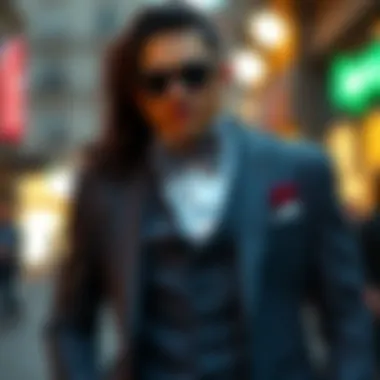
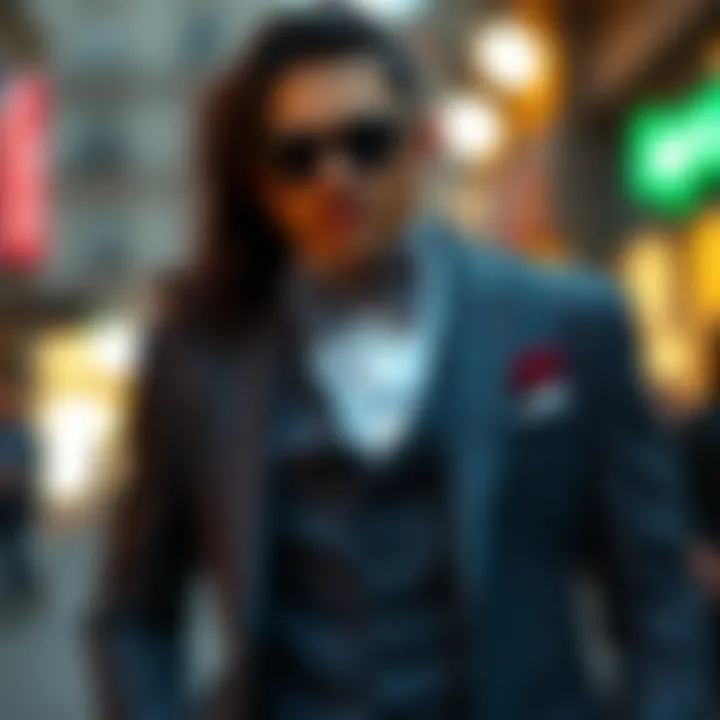
Storing your suit properly is equally important as cleaning it. A well-organized wardrobe can protect your garments from dust, creases, and moths. Here are a few pointers for optimal storage:
- Use a breathable garment bag: This keeps dust at bay while allowing the fibers to breathe, preventing unnecessary moisture build-up.
- Hang correctly: Always use a wide, padded hanger for suits. This helps maintain the shape of the shoulders and prevents unwanted creasing.
- Avoid cramped spaces: Ensure that suits are not cramped; they need room to hang freely without being squished.
- Moth protection: Storing lavender sachets or cedar blocks in the wardrobe acts as a natural deterrent against moths.
Maintaining Bowtie Shape and Appearance
The bowtie, often an understated yet crucial element, requires special attention to maintain its structure and appearance. Over time, it can lose its shape if not cared for properly. Here’s how to keep that bowtie looking sharp:
- Proper storage: Instead of tossing the bowtie in a drawer, consider keeping it in a designated bowtie box or pouch to maintain its form.
- Avoid excessive pulling: When fastening or untieing, do it gently to prevent stressing the fabric.
- Regular reshaping: If the bowtie looks limp, give it a gentle squeeze or roll it between your fingers to restore its shape. A light steaming can also help, but avoid direct contact with the fabric.
"Caring for your suit and accessories protects your investment while ensuring you always put your best foot forward."
Creating a versatile and stylish look with the suit, vest, and bowtie ensemble doesn’t just lie in the selection of pieces but greatly in how they are treated over time. Following these care and maintenance practices will help you keep your elegant attire in top shape, ready for any occasion.
Sustainable Fashion Practices
In today's fast-paced world, the fashion industry faces increasing scrutiny over its environmental impact. Sustainable fashion isn't just a buzzword tossed around by trendsetters; it's imperative for the survival of our planet. When it comes to the classic ensemble of a suit, vest, and bowtie, adopting sustainable practices can significantly influence both the industry and personal style. It's about responsible choices that align with values of quality, ethics, and fashion innovation, all while promoting longevity in garments.
Ethical Fabric Sourcing
Ethical fabric sourcing refers to the practice of acquiring materials in a manner that respects both the environment and those who produce them. This practice can encompass a variety of materials that utilize eco-friendly processes, such as organic cotton, recycled polyester, and even ethically sourced wool. When you opt for fabrics that are made with lower environmental footprints, you're not just making a fashionable choice but also advocating for better practices in the industry.
Here are some considerations when choosing ethically sourced fabrics:
- Transparency: Check the brand's commitment to sourcing materials responsibly. Look for certifications like Global Organic Textile Standard (GOTS) or Fair Trade.
- Durability: Opt for materials that boast durability; high-quality garments often last much longer, reducing the need for frequent replacements.
- Reduced Chemicals: Fabrics processed without harmful chemicals are better for the environment and for your skin.
Making conscious decisions about your fabric choices not only enhances your style but also contributes positively to the larger fashion ecosystem.
Secondhand and Vintage Options
Exploring secondhand and vintage clothing is one of the more enjoyable and rewarding aspects of sustainable fashion. Each piece carries its own unique story, and incorporating these items into your wardrobe can make a distinctive statement, setting your style apart from the crowd. The charm of vintage ensembles is that they often showcase craftsmanship and designs that aren’t replicated in contemporary pieces.
Here are some benefits of considering secondhand and vintage clothing:
- Environmental Impact: Buying pre-owned clothes helps reduce waste and the demand for new production, which is often resource-intensive.
- Cost-Effective: Vintage and secondhand clothing can be much more affordable than buying new while offering outstanding quality.
- Unique Finds: You’re less likely to bump into someone else wearing the same outfit when you source from thrift stores or antique shops.
Future Trends in Suit-Wearing
The landscape of men's fashion is ever-evolving, especially when it comes to the suit, vest, and bowtie ensemble. Staying in tune with future trends is crucial not just for style aficionados but also for designers, retailers, and stylists looking to cater to a discerning clientele. These trends provide a glimpse into how traditional elements are reimagined, pushing the boundaries of classic menswear while maintaining elegance and sophistication.
Innovative Design Approaches
In the realm of menswear, innovative design approaches are redefining how we perceive suits, vests, and bowties. Gone are the days when a suit was merely functional—today, it's a canvas for creativity.
Designers are increasingly integrating unconventional cuts and bold silhouettes into their collections, making a significant deviation from a standard fit. Instead of just a two-piece suit, you might find three-piece suits designed with asymmetrical vests or jackets that deviate from the usual length—a mix of tailored aesthetics with a hint of avant-garde.
- Layering: This trend promotes not only visual interest but also practicality. By layering a vest under an open jacket, the look remains suave while offering warmth in cooler months.
- Customization: Tailoring is becoming less about the perfect fit and more about personalization. Customizable options, from buttons to fabric choices and lining colors, are now available, giving individuals more power over their style.
- Gender Fluidity: The lines between traditionally masculine and feminine designs are blurring. Many designers are crafting suits that cater to all genders, embodying a more inclusive concept in formal wear.
These innovations reflect a broader cultural shift towards individualism and self-expression. Consumers are drawn to suits that tell a story, showcasing creativity without sacrificing elegance.
Tech-Driven Fabrics
As we approach a future where technology intertwines more deeply with fashion, tech-driven fabrics are making waves in the world of suits. The incorporation of advanced textiles not only influences style but also the overall wearing experience.
- Moisture-Wicking Properties: Fabrics are now engineered to manage sweat more effectively, keeping the wearer dry and comfortable throughout long events or workdays. Such functionalities can be particularly beneficial in warmer climates or during summer gatherings.
- Smart Textiles: Some forward-thinking brands are experimenting with fabrics that can change colors or patterns based on temperature or mood, creating an interactive layer of personalization in attire.
- Sustainability Integration: Eco-friendly fabrics are also gaining traction. Designers are opting for materials made from recycled plastics or organic cotton, which aligns with the growing trend of sustainable fashion.
Tomorrow's suits won't just look sharp; they will have the added benefit of enhancing the wearer's comfort, adaptability, and environmental friendliness. This indicates a future where style meets practicality, allowing for a seamless transition from work to a more formal setting without compromising on comfort.
"Fashion trends are not mere fads; they mirror society's evolution and individual expression."
By understanding and embracing these upcoming trends, those in the fashion industry can better serve clients who are increasingly seeking unique and tailored looks that address both style and functionality.
Final Thoughts on the Ensemble's Significance
The culmination of the conversation surrounding a suit, vest, and bowtie rests in their shared significance as more than mere fabric and thread; they represent a tapestry of cultural identity and personal expression. Each component holds a rich history and a prominent place in the wardrobes of men, indicating their lifestyle, status, and even their emotional states. The ensemble does not just adorn the wearer but becomes a canvas of self-representation.
The timelessness of formal attire underscores several social dynamics. Regardless of the ebb and flow of fashion fads, the classic combination persists in its ability to convey respect for tradition and social norms. In many professional and personal spheres, donning such attire signifies a commitment to excellence and an acknowledgment of the occasion. Situations ranging from upscale weddings to high-stakes meetings often call for a suit with a vest and bowtie, invoking a sense of gravitas and gravitating attention from peers and onlookers alike. The authority exuded by this ensemble can often open doors and create opportunities.
"Dressing well is a form of good manners." — Tom Ford
Moreover, the ensemble also allows for personal expression through style. Each piece offers a variety of choices, whether in terms of color, fabric, or fit. For instance, a tailored vest in a rich, deep emerald can convey a luxurious air, while a classic black bowtie speaks to tradition and subtlety. These nuances reflect one’s personality and often tell stories about the individual beyond mere words.
This aspect becomes particularly relevant in an age where individuality is celebrated. Individuals might choose to combine unconventional patterns, play with textures, or mix vibrant colors, allowing their attire to echo their unique narrative. For fashion designers, stylists, and even educators in this field, these facets of the ensemble provoke discussions about interpreting norms and encourages an exploration of how tradition can mesh with modernity.
Consequently, the suit with vest and bowtie stands as an emblem of sartorial elegance and sophisticated choices. Understanding their significance aids in navigating both fashion and society, offering insights into how attire influences interactions. As we continue to move toward a future that embraces personal storytelling through clothing choices, the classic trio's roles will evolve while remaining foundational pillars in men's fashion.















